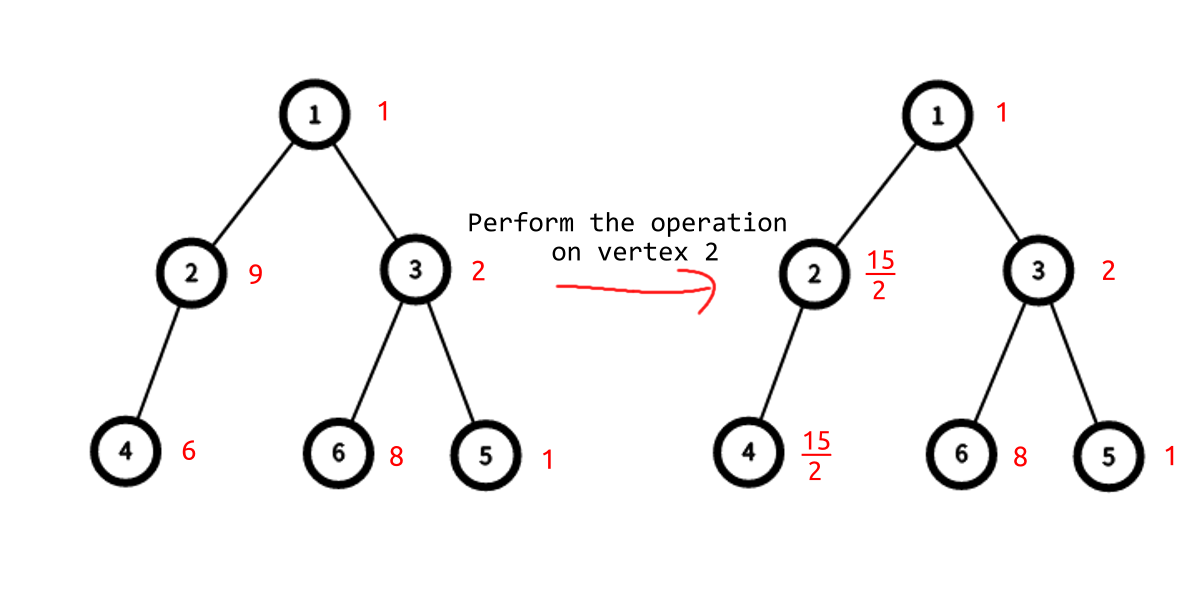CF1889F.Doremy's Average Tree
普及/提高-
通过率:0%
AC君温馨提醒
该题目为【codeforces】题库的题目,您提交的代码将被提交至codeforces进行远程评测,并由ACGO抓取测评结果后进行展示。由于远程测评的测评机由其他平台提供,我们无法保证该服务的稳定性,若提交后无反应,请等待一段时间后再进行重试。
题目描述
Doremy has a rooted tree of size n whose root is vertex r . Initially there is a number wi written on vertex i . Doremy can use her power to perform this operation at most k times:
- Choose a vertex x ( 1≤x≤n ).
- Let s=∣T∣1∑i∈Twi where T is the set of all vertices in x 's subtree.
- For all i∈T , assign wi:=s .
Doremy wants to know what is the lexicographically smallest † array w after performing all the operations. Can you help her?
If there are multiple answers, you may output any one.
† For arrays a and b both of length n , a is lexicographically smaller than b if and only if there exist an index i ( 1≤i≤n ) such that ai<bi and for all indices j such that j<i , aj=bj is satisfied.
输入格式
The input consists of multiple test cases. The first line contains a single integer t ( 1≤t≤104 ) — the number of test cases. The description of the test cases follows.
The first line contains three integers n , r , k ( 2≤n≤5000 , 1≤r≤n , 0≤k≤min(500,n) ).
The second line contains n integers w1,w2,…,wn ( 1≤wi≤106 ).
Each of the next n−1 lines contains two integers ui , vi ( 1≤ui,vi≤n ), representing an edge between ui and vi .
It is guaranteed that the given edges form a tree.
It is guaranteed that the sum of n does not exceed 50000 .
输出格式
For each test case, In the first line, output a single integer cnt ( 0≤cnt≤k ) — the number of operations you perform.
Then, in the second line output cnt integers p1,p2,…,pcnt — x is chosen to be pi for i -th operation.
If there are multiple answers, you may output any one.
输入输出样例
输入#1
4 6 1 1 1 9 2 6 1 8 1 2 1 3 2 4 3 6 3 5 7 7 2 3 1 3 3 1 1 2 7 1 7 2 7 4 1 5 2 3 4 6 6 5 1 3 1 3 1 1 3 5 3 5 1 5 6 3 4 1 2 3 2 1 1000000 999999 999997 2 1 1 3
输出#1
1 2 2 1 4 1 5 1 1
说明/提示
In the first test case:

At first w=[1,9,2,6,1,8] . You can choose some vertex x to perform at most one operation.
- If x=1 , w=[29,29,29,29,29,29] .
- If x=2 , w=[1,215,2,215,1,8] .
- If x=3 , w=[1,9,311,6,311,311] .
- If x∈{4,5,6} , w=[1,9,2,6,1,8] .
- If you don't perform any operation, w=[1,9,2,6,1,8] .
w is lexicographically smallest when x=2 .